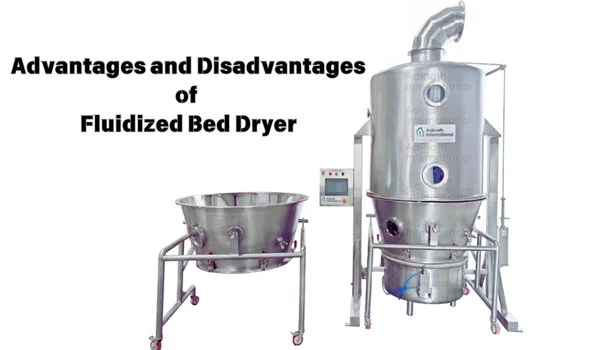Fluidized bed dryers (FBD) are a widely used drying technology in various industries, including pharmaceuticals, food processing, chemicals, and agriculture. This drying method involves passing hot air through a perforated bed containing the material to be dried. The high-velocity airflow causes the material to behave like a fluid, ensuring efficient and uniform drying. While the fluidized bed dryer offers significant advantages, it also has some limitations. This article explores the advantages and disadvantages of fluidized bed dryers in detail.
What is a Fluidized Bed Dryer?
A fluidized bed dryer is a type of industrial dryer where the material to be dried is placed in a perforated chamber. Hot air is passed through the chamber at a velocity that suspends the particles, creating a fluidized state. This ensures that each particle is surrounded by hot air, leading to efficient heat and mass transfer.

Advantages of Fluidized Bed Dryer
1. Efficient Heat and Mass Transfer
The fluidized state ensures excellent contact between the hot air and the material, leading to faster and more efficient drying compared to traditional methods.
2. Uniform Drying
The turbulent movement of particles ensures uniform heat distribution, preventing overheating or uneven drying of the material.
3. Reduced Drying Time
Fluidized bed dryers can significantly reduce drying time due to their efficient heat transfer and high drying rates.
4. Versatility
They are suitable for drying a wide range of materials, including powders, granules, and small-sized particles, making them applicable across various industries.
5. Energy Efficiency
The drying process uses energy effectively, reducing operational costs, especially when drying materials with low moisture content.
6. Scalability
Fluidized bed dryers are available in various sizes and configurations, making them adaptable to both small-scale and large-scale operations.
7. Improved Product Quality
The gentle fluidized action prevents material degradation, resulting in high-quality, evenly dried products.
8. Easy to Operate and Clean
These dryers have a simple design, making them easy to operate, clean, and maintain, which is particularly beneficial in industries requiring high hygiene standards.
9. Continuous Operation
Fluidized bed dryers can operate continuously, making them ideal for large production volumes.
10. Control Over Parameters
Operators can control parameters like temperature, airflow, and drying time to achieve precise drying results.
Disadvantages of Fluidized Bed Dryer
1. High Initial Cost
Fluidized bed dryers require significant upfront investment in equipment and infrastructure, which can be a barrier for small businesses.
2. High Energy Consumption for Initial Setup
The process requires high airflow and initial energy input, especially when drying materials with high moisture content.
3. Not Suitable for All Materials
The process is less effective for materials that are sticky, viscous, or have irregular shapes, as these may agglomerate or clog the system.
4. Risk of Particle Attrition
The constant movement of particles can cause attrition, leading to dust formation or damage to fragile materials.
5. Complex Operation for Certain Materials
While the system is generally easy to operate, drying certain materials may require additional expertise and adjustments to prevent issues like fluidization failure.
6. Limited Temperature Range
Some fluidized bed dryers may not be suitable for drying materials that require very high or very low temperatures.
7. Potential for Overheating
Without proper control, there is a risk of overheating, which can degrade sensitive materials.
8. Air Pollution Concerns
Dust and fine particles generated during the drying process can lead to air pollution if not properly contained using filters or dust collectors.
9. Maintenance Requirements
Regular maintenance is necessary to prevent issues like clogging of the perforated plate or wear and tear of components.
10. Noise and Vibration
The high airflow velocity and movement of particles can generate noise and vibration, requiring additional measures for noise reduction.
Comparison Table: Advantages vs. Disadvantages
| Advantages | Disadvantages |
|---|---|
| Efficient heat and mass transfer | High initial equipment cost |
| Uniform and consistent drying | High energy consumption for setup |
| Reduced drying time | Not suitable for sticky or irregular materials |
| Versatile for different materials | Risk of particle attrition and dust formation |
| Energy-efficient for low moisture content | Requires skilled operation for complex materials |
| Scalable for various production sizes | Limited temperature range for certain materials |
| High-quality output | Potential for overheating sensitive materials |
| Easy to operate and clean | Air pollution concerns due to dust |
| Continuous operation | Regular maintenance required |
| Adjustable drying parameters | Noise and vibration issues |
Applications of Fluidized Bed Dryers
- Pharmaceutical Industry:
Used for drying powders, granules, and tablet formulations while maintaining high product quality. - Food Processing:
Drying food products such as grains, cereals, and spices to ensure uniform moisture removal. - Chemical Industry:
Drying chemicals, catalysts, and intermediates to maintain their purity and effectiveness. - Agriculture:
Drying seeds, fertilizers, and agricultural products to extend their shelf life. - Environmental Sector:
Used for drying sludge, waste materials, or biomass in eco-friendly operations.
Best Practices for Fluidized Bed Dryers
- Material Compatibility:
Ensure the material is suitable for fluidized drying to prevent clogging or agglomeration. - Regular Maintenance:
Clean and inspect the perforated plate and other components regularly to avoid operational issues. - Dust Control:
Use proper dust collection systems to minimize air pollution and maintain safety. - Temperature Monitoring:
Monitor and control temperature precisely to prevent overheating sensitive materials. - Noise Reduction:
Install soundproofing measures to reduce noise levels in the operational environment.
Conclusion
The fluidized bed dryer is an efficient and versatile drying technology that provides significant advantages in terms of speed, uniformity, and energy efficiency. Its ability to produce high-quality, uniformly dried products makes it a preferred choice across various industries. However, it is essential to address its limitations, such as high initial costs, material compatibility, and maintenance requirements, to fully leverage its benefits.
By understanding the advantages and disadvantages of fluidized bed dryers, businesses can make informed decisions about whether this technology aligns with their production needs. With proper maintenance, operation, and safety measures, fluidized bed dryers can be a valuable asset in modern manufacturing processes.

Hello, I’m Kapil Kumar, a seasoned SEO expert and blogger at WinnersList.in. My mission is to spotlight exceptional individuals and organizations across various domains. Through curated lists, profiles, and inspiring stories, I aim to celebrate outstanding achievements and inspire the next generation of champions. Join me in this journey.
